
Instead of suitcases, foster youth are often given trash bags to transport their belongings from placement to placement. For one youth, garbage bags evoke memories of shame. “The clear ones were the worst, because you could see through them.” She remembers holding her most prized possessions tightly in her arms, so they wouldn’t get damaged or lost if the bag ripped.

A hospital gown can become an institutionalized youth’s entire wardrobe. This thin garment served as a foster youth’s daytime clothing, robe, and pajamas. Teen years are characterized by an acute attention to fashion and clothing. Imagine the impact on a teenager’s self-image after being forced to only wear a hospital gown day after day, week after week.
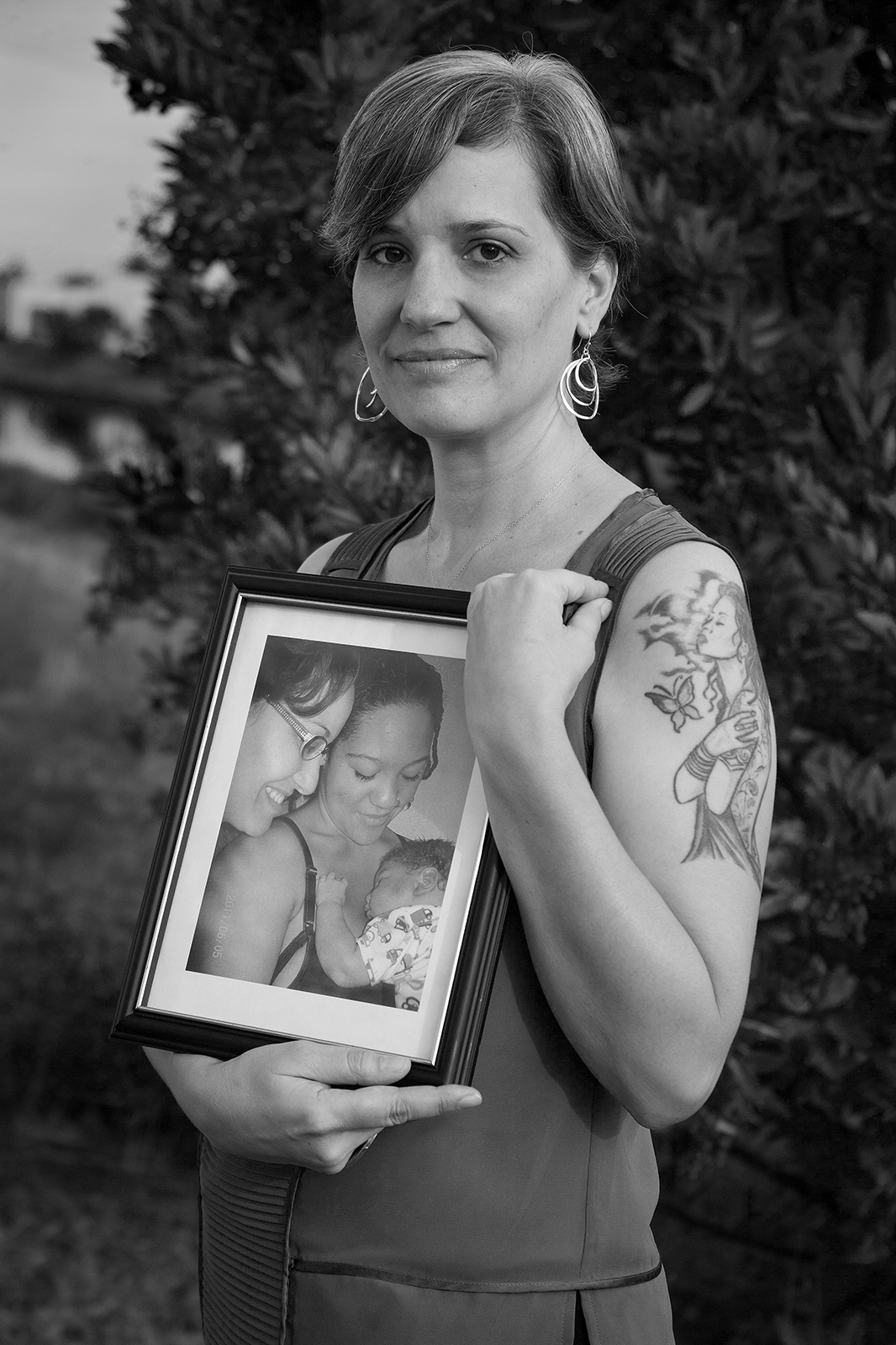
This woman has broken the cycle of trauma that is so prevalent in foster youths’ lives. She broke that cycle for her daughter and is now a proud mother and abuelita (grandmother). Her daughter is now in law school.
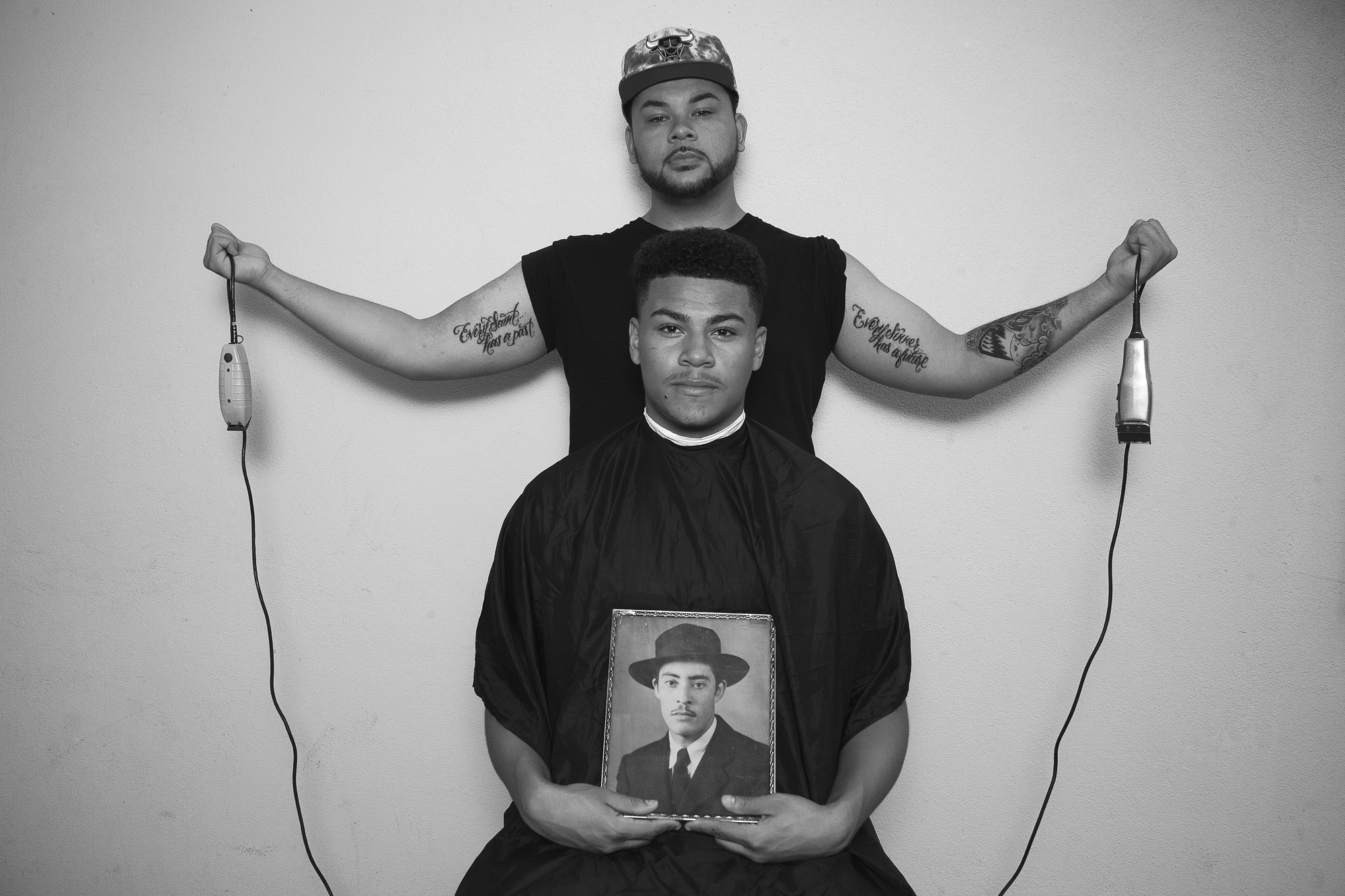
“I don’t want to be the statistic of a Foster Youth.”
His tattoo represents his belief that you should never give up on yourself, and that you can succeed no matter what. It was inspired by Immortal Technique, an urban activist rapper. Gilbert was especially struck by the lyrics, “Every saint has a past, every sinner has a future”, as he felt they defined him. Gilbert was able to graduate high school; and since then, he has gone on to learn multiple languages, supports himself, and is an accomplished barber.

Anastasia and her twin sister Aja were the only infants to survive a birth of quintuplets. The two twins were born with their hands fused together. Although the sisters were placed in different foster homes, thereby separating them for a number of years, it is not surprising that the two sisters have reunified and established an incredibly close relationship.

This photograph is of Sade at one of her favorite places in the world: a library. Sade grew up defending herself, fighting back and knowing how hard it is to survive in Oakland. Libraries were a safe space for her—a place to let down armor and explore new worlds. Sade went on to attend a historically black college and is now in graduate school at the University of California at Berkeley.
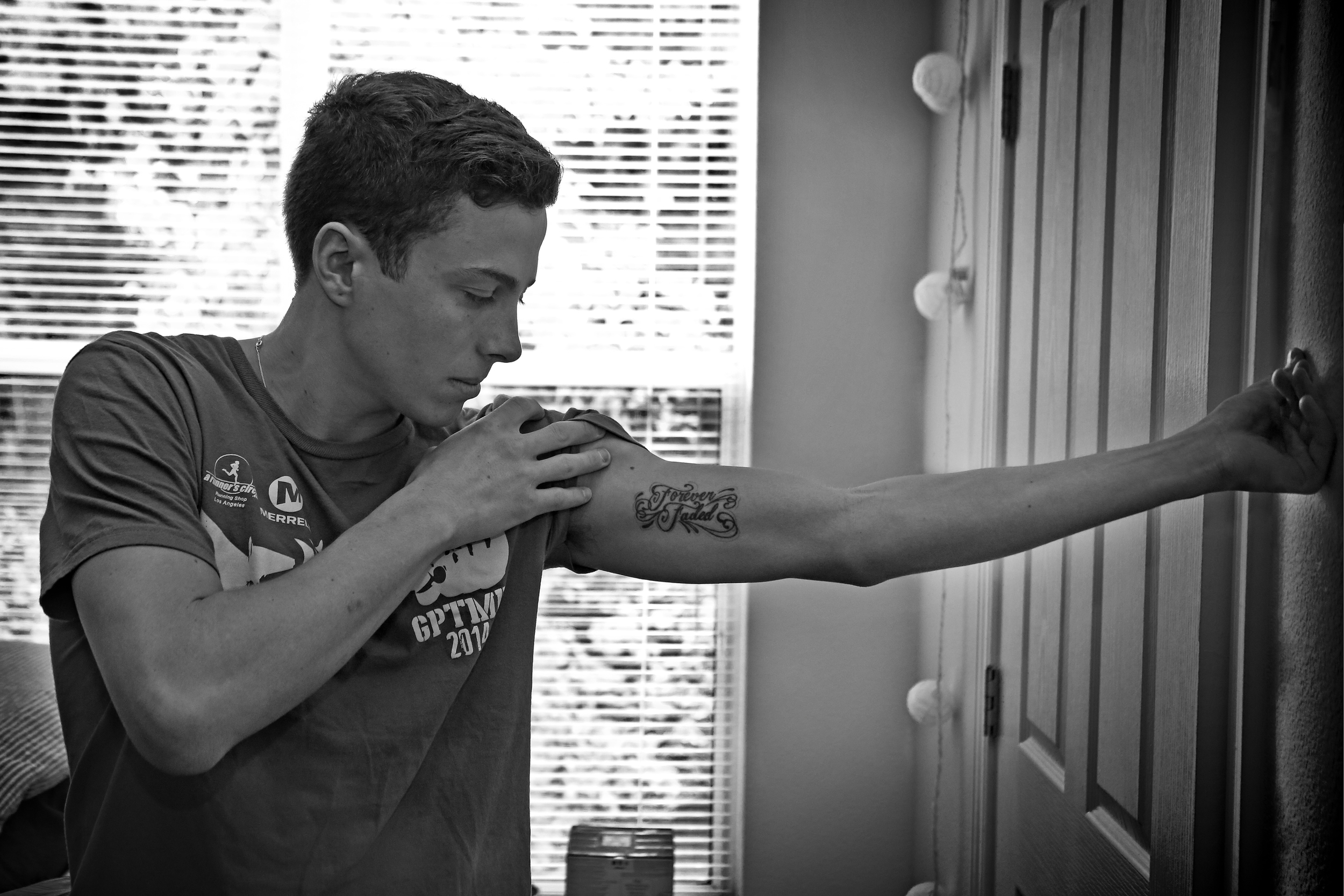
This youth once had a goal to be high every day. His tattoo, "forever faded", was his commitment to that goal. Many foster youth use drugs and alcohol to self-medicate for emotional pain, confusion and the feeling of being lost. It is important for youth to receive comfort, support, love and attention. When this happens, the need to fade out ...fades out.

Due to lack of support and affordable housing alternatives, many youth who emancipate from care find themselves outdoors and homeless. Sleeping bags that provide adequate protection are usually beyond the budget of a homeless youth. Youth are left to use cheaper sleeping bags that leave them exposed to harsh environmental conditions. There is also a strong stigma to being homeless and police harassment is common.
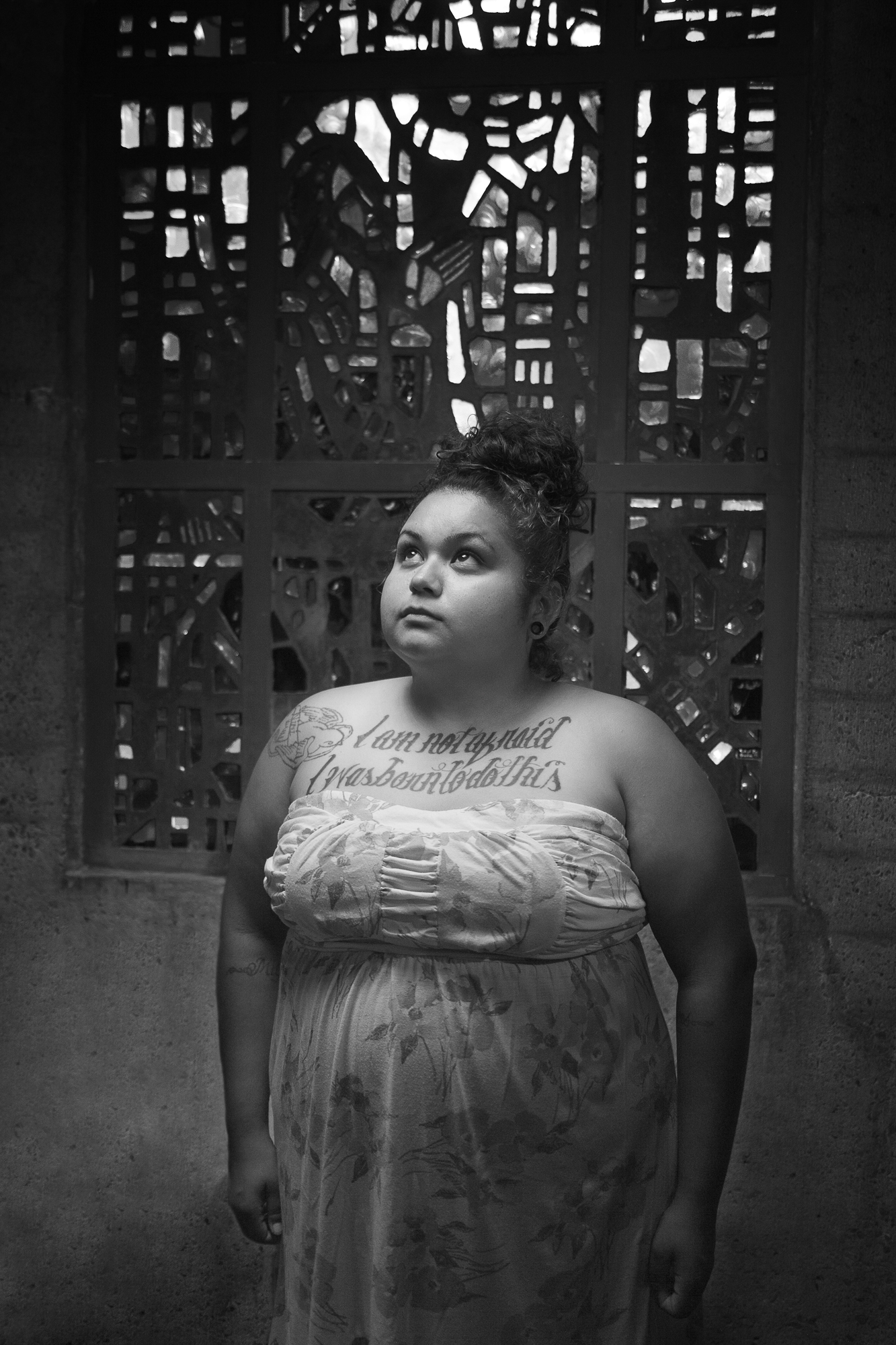
“This is a big part of me, it’s my identity.”
Throughout her life, Marcy was able to confront and overcome many difficulties, such as addiction and sexual abuse. Even when faced with these challenges, Marcy sought to focus on the positives. Her firm belief that everything happens for a reason and that her life has a bigger purpose gave her the strength to keep fighting. Getting her tattoo, which reads: “I’m not afraid I was born to do this”, was a way for her to validate her ability to survive. Although her tattoo sometimes prevents work opportunities and causes her to experience judgement from others, Marcy would never consider removing it.
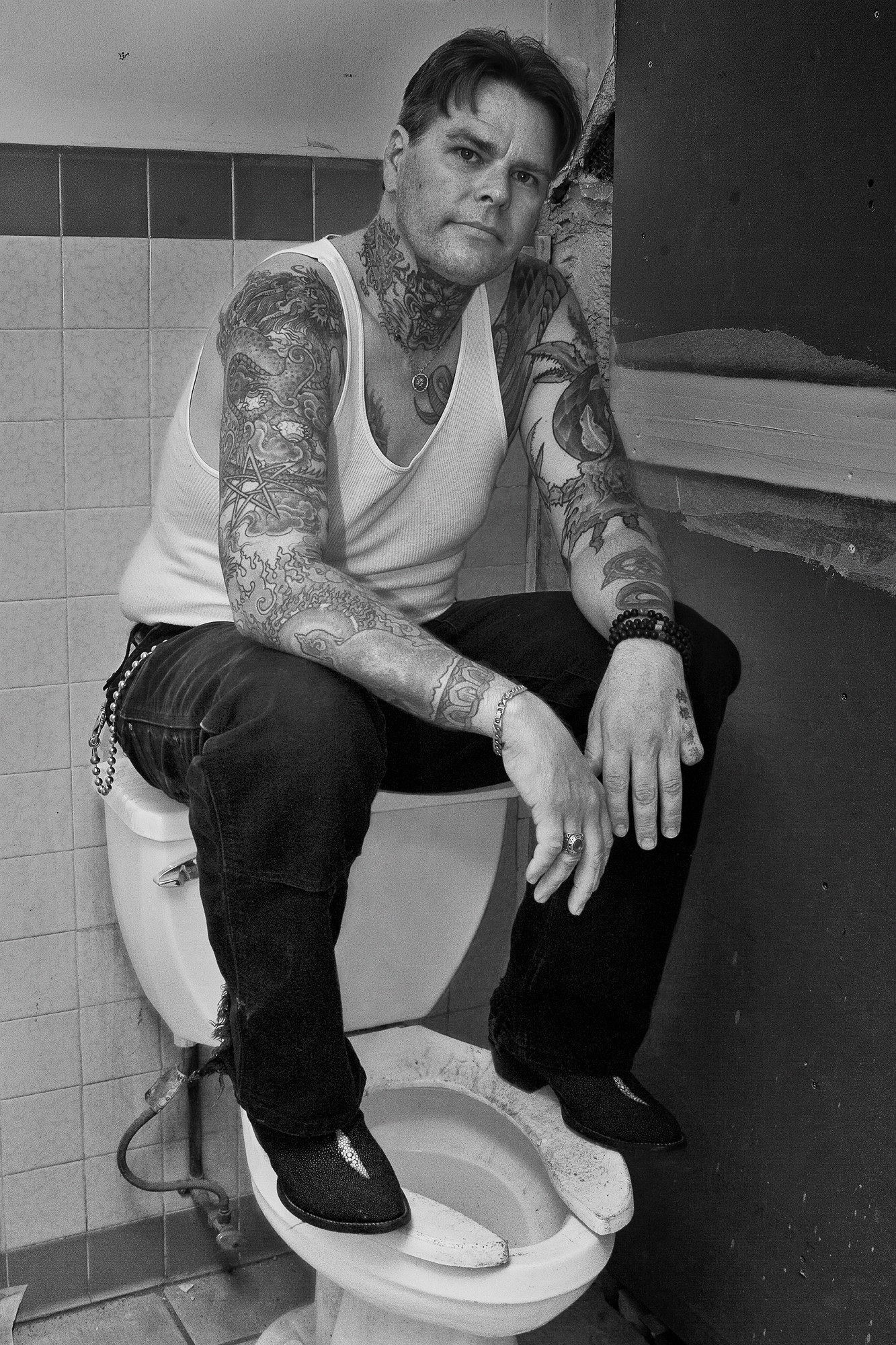
“I’m a nester. I’m a Cancer, Cancers, man, we love to nest—I build my nest! Getting a tattoo was sort of some of the twigs of my nest that would never leave me. In that intellectual, spiritual sense of an emotional nest.”
Throughout Russell’s life he lacked a sense of structure and permanence. Until he was 9 he lived a carnie lifestyle with his biological family. After which, he bounced between living on the streets and in foster care. Many foster youth struggle with not having a space to call their own, and for Russell, he found that getting tattoos was a way for him to create a space that no one could take away from him. His tattoos became a permanent structure, a spiritual home that he could hold on to. Having found a sense of stability, Russell realized that he was not living up to his full potential and it was time to reexamine his life. At 43 years old he was able to get his GED and enrolled in UC Berkeley, double majoring in Anthropology and East Asian Studies. He plans to apply to law school and continue his education to eventually earn his PhD.
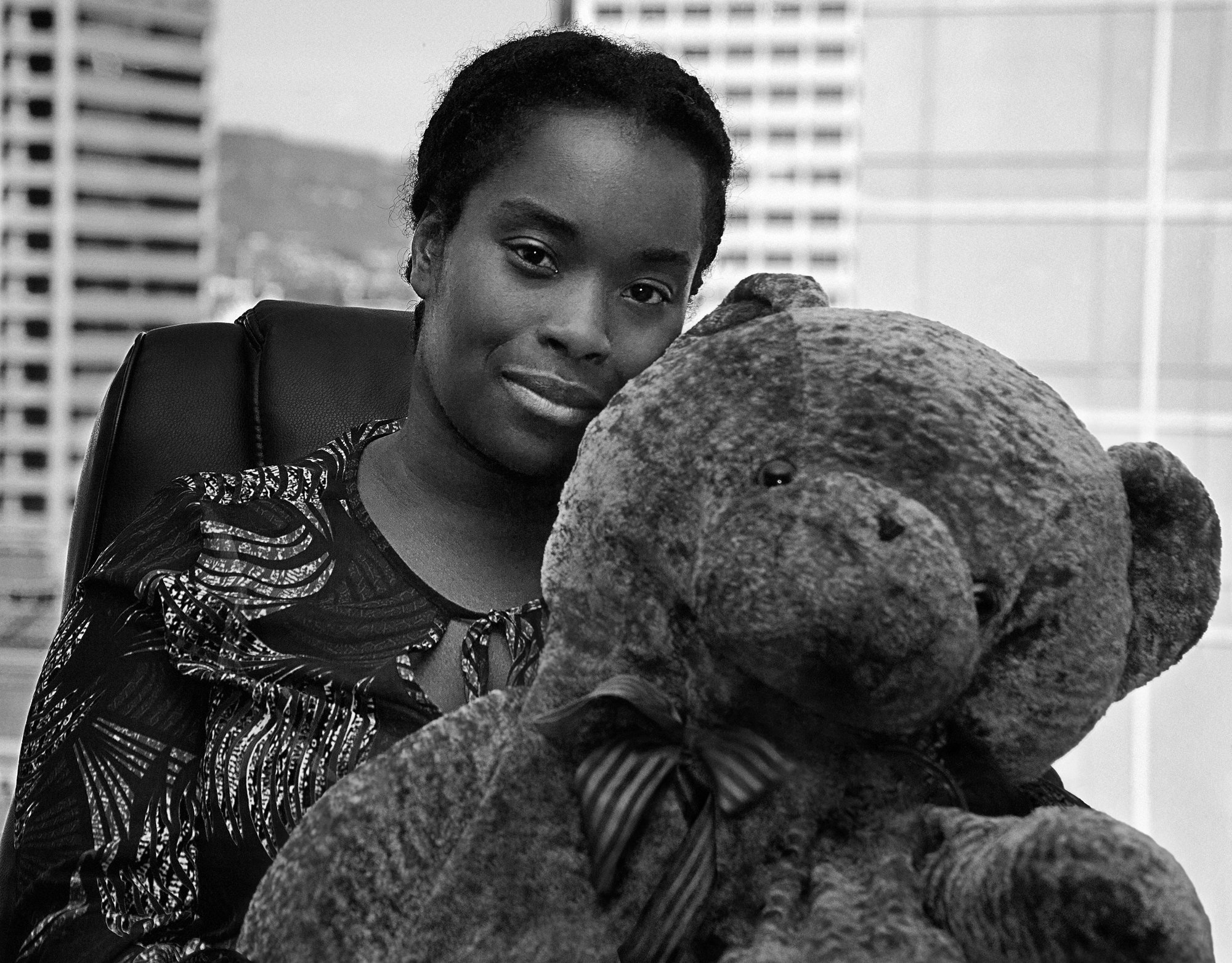
Teddy bears are often a source of comfort for children throughout different life events and transitions. A youth’s biological sister, who lived in a different residential facility, gave her this bear as a tangible connection to her sister and source of comfort as she transitioned from placement to placement.
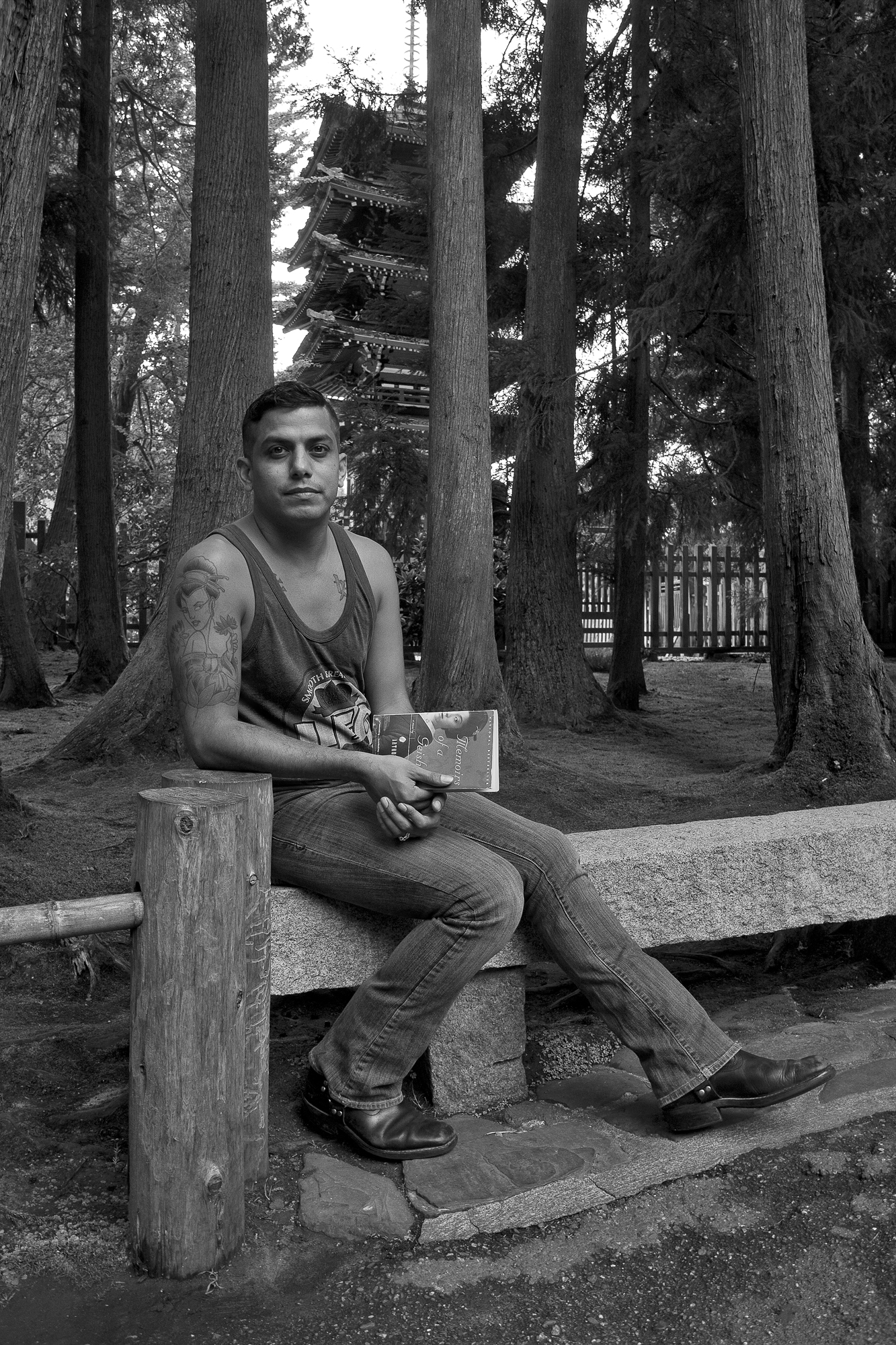
“I made my life happen. I created my life, and people don’t feel like they have that power to do that.”
After running away from kinship care at the age of 13, Valentino was living in shelters and working the streets of Los Angeles. Becoming victims of CSEC (Commercial Sexual Exploitation of Children) is a common scenario for many foster youth because of the lack of stability and support in their lives. However, Valentino was able to find strength in his relationship with God and his desire to create a better life for himself. Valentino’s tattoo was inspired by the story told in Memoirs of a Geisha; as the idea of being taken away from your home and being forced to entertain men, resonated with him. The tattoo serves as a reminder of his former life.
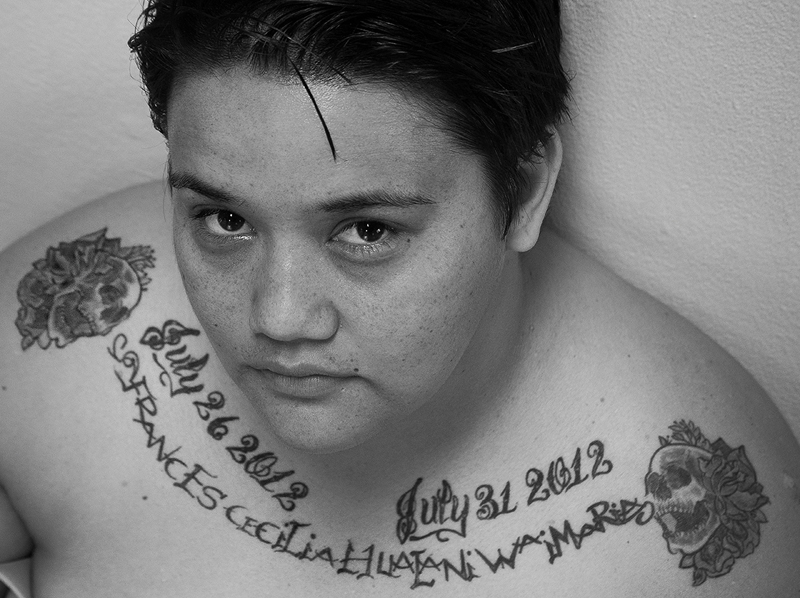
“I need them—it’s the first thing that I look for in the morning. I can’t ever see myself not having them.”
Ipo's chest piece was a way for her to release pain and come to terms with her identity. The skull, bouquet, and four names symbolize the women in her life that provided her both heartache and love; and ultimately made her the woman that she is today. The dates were added after Ipo attended a conference where she experienced truly seeing herself for the fist time and began to build her chosen family, with whom she is still very close to today.
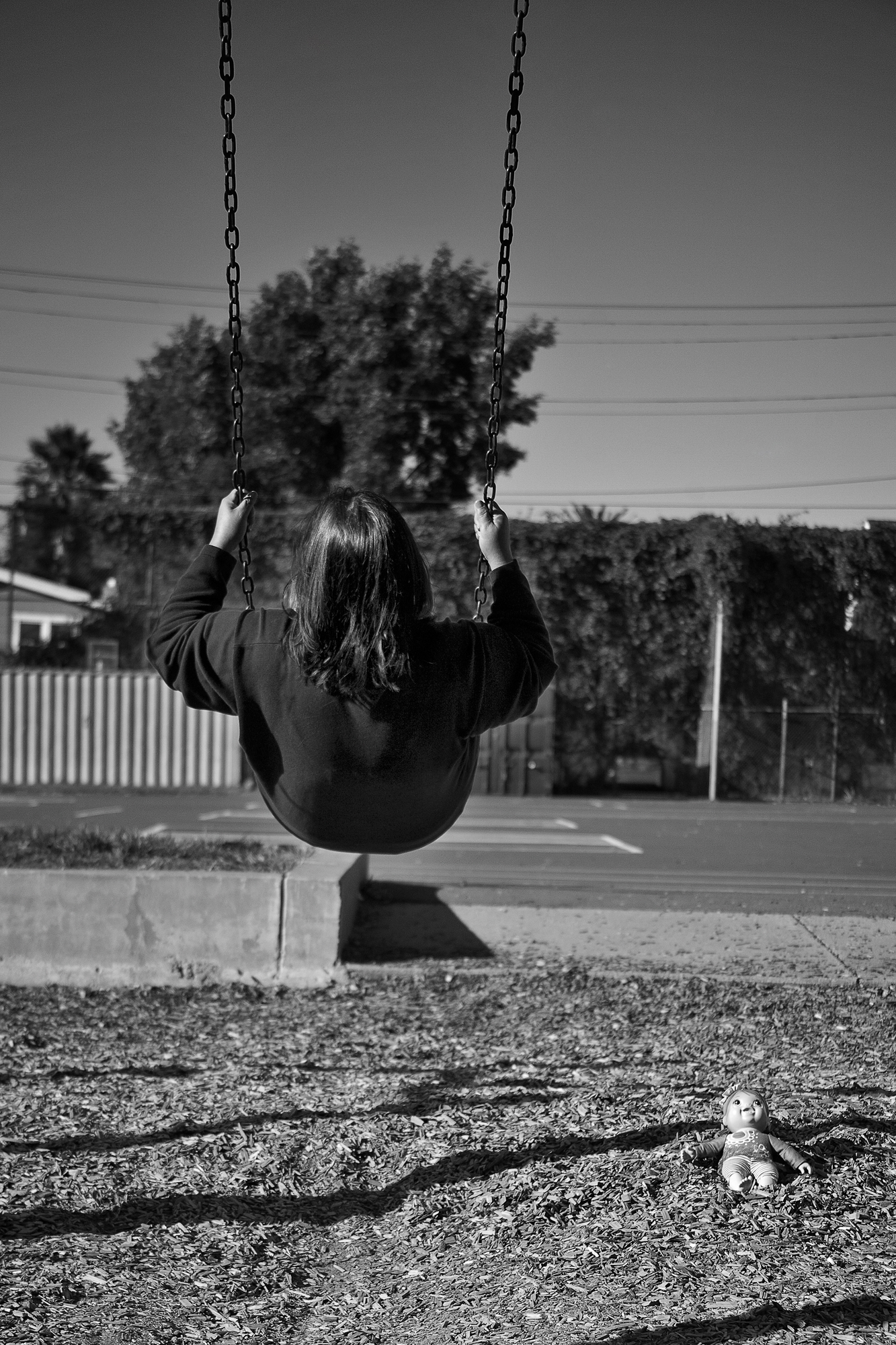
While Julia’s swing story includes the experience of loss and sorrow, it also can be interpreted through the lens of joy. Julia, now 48, still remembers the elated feeling she had while swinging that morning. Identifying joy and freedom in life is an essential part of healing, health and embodiment.

A common narrative in a youth’s entry into foster care includes alcohol and drugs. This is particularly true if their parents are habitual users. For some youth, the use of drugs and alcohol can become a coping mechanism to deal with trauma, grief and loss. Being faced with breaking the cycle of generational addiction is an enormous burden to inherit.















Instead of suitcases, foster youth are often given trash bags to transport their belongings from placement to placement. For one youth, garbage bags evoke memories of shame. “The clear ones were the worst, because you could see through them.” She remembers holding her most prized possessions tightly in her arms, so they wouldn’t get damaged or lost if the bag ripped.
A hospital gown can become an institutionalized youth’s entire wardrobe. This thin garment served as a foster youth’s daytime clothing, robe, and pajamas. Teen years are characterized by an acute attention to fashion and clothing. Imagine the impact on a teenager’s self-image after being forced to only wear a hospital gown day after day, week after week.
This woman has broken the cycle of trauma that is so prevalent in foster youths’ lives. She broke that cycle for her daughter and is now a proud mother and abuelita (grandmother). Her daughter is now in law school.
“I don’t want to be the statistic of a Foster Youth.”
His tattoo represents his belief that you should never give up on yourself, and that you can succeed no matter what. It was inspired by Immortal Technique, an urban activist rapper. Gilbert was especially struck by the lyrics, “Every saint has a past, every sinner has a future”, as he felt they defined him. Gilbert was able to graduate high school; and since then, he has gone on to learn multiple languages, supports himself, and is an accomplished barber.
Anastasia and her twin sister Aja were the only infants to survive a birth of quintuplets. The two twins were born with their hands fused together. Although the sisters were placed in different foster homes, thereby separating them for a number of years, it is not surprising that the two sisters have reunified and established an incredibly close relationship.
This photograph is of Sade at one of her favorite places in the world: a library. Sade grew up defending herself, fighting back and knowing how hard it is to survive in Oakland. Libraries were a safe space for her—a place to let down armor and explore new worlds. Sade went on to attend a historically black college and is now in graduate school at the University of California at Berkeley.
This youth once had a goal to be high every day. His tattoo, "forever faded", was his commitment to that goal. Many foster youth use drugs and alcohol to self-medicate for emotional pain, confusion and the feeling of being lost. It is important for youth to receive comfort, support, love and attention. When this happens, the need to fade out ...fades out.
Due to lack of support and affordable housing alternatives, many youth who emancipate from care find themselves outdoors and homeless. Sleeping bags that provide adequate protection are usually beyond the budget of a homeless youth. Youth are left to use cheaper sleeping bags that leave them exposed to harsh environmental conditions. There is also a strong stigma to being homeless and police harassment is common.
“This is a big part of me, it’s my identity.”
Throughout her life, Marcy was able to confront and overcome many difficulties, such as addiction and sexual abuse. Even when faced with these challenges, Marcy sought to focus on the positives. Her firm belief that everything happens for a reason and that her life has a bigger purpose gave her the strength to keep fighting. Getting her tattoo, which reads: “I’m not afraid I was born to do this”, was a way for her to validate her ability to survive. Although her tattoo sometimes prevents work opportunities and causes her to experience judgement from others, Marcy would never consider removing it.
“I’m a nester. I’m a Cancer, Cancers, man, we love to nest—I build my nest! Getting a tattoo was sort of some of the twigs of my nest that would never leave me. In that intellectual, spiritual sense of an emotional nest.”
Throughout Russell’s life he lacked a sense of structure and permanence. Until he was 9 he lived a carnie lifestyle with his biological family. After which, he bounced between living on the streets and in foster care. Many foster youth struggle with not having a space to call their own, and for Russell, he found that getting tattoos was a way for him to create a space that no one could take away from him. His tattoos became a permanent structure, a spiritual home that he could hold on to. Having found a sense of stability, Russell realized that he was not living up to his full potential and it was time to reexamine his life. At 43 years old he was able to get his GED and enrolled in UC Berkeley, double majoring in Anthropology and East Asian Studies. He plans to apply to law school and continue his education to eventually earn his PhD.
Teddy bears are often a source of comfort for children throughout different life events and transitions. A youth’s biological sister, who lived in a different residential facility, gave her this bear as a tangible connection to her sister and source of comfort as she transitioned from placement to placement.
“I made my life happen. I created my life, and people don’t feel like they have that power to do that.”
After running away from kinship care at the age of 13, Valentino was living in shelters and working the streets of Los Angeles. Becoming victims of CSEC (Commercial Sexual Exploitation of Children) is a common scenario for many foster youth because of the lack of stability and support in their lives. However, Valentino was able to find strength in his relationship with God and his desire to create a better life for himself. Valentino’s tattoo was inspired by the story told in Memoirs of a Geisha; as the idea of being taken away from your home and being forced to entertain men, resonated with him. The tattoo serves as a reminder of his former life.
“I need them—it’s the first thing that I look for in the morning. I can’t ever see myself not having them.”
Ipo's chest piece was a way for her to release pain and come to terms with her identity. The skull, bouquet, and four names symbolize the women in her life that provided her both heartache and love; and ultimately made her the woman that she is today. The dates were added after Ipo attended a conference where she experienced truly seeing herself for the fist time and began to build her chosen family, with whom she is still very close to today.
While Julia’s swing story includes the experience of loss and sorrow, it also can be interpreted through the lens of joy. Julia, now 48, still remembers the elated feeling she had while swinging that morning. Identifying joy and freedom in life is an essential part of healing, health and embodiment.
A common narrative in a youth’s entry into foster care includes alcohol and drugs. This is particularly true if their parents are habitual users. For some youth, the use of drugs and alcohol can become a coping mechanism to deal with trauma, grief and loss. Being faced with breaking the cycle of generational addiction is an enormous burden to inherit.